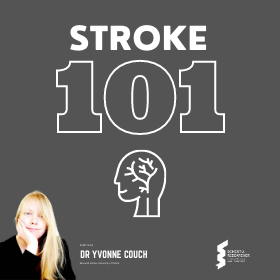Morning folks. Or afternoon. Or whenever you’re reading this. Or listening. I’ll get these intros down pat soon, don’t worry. In the meantime, strap yourselves in because today we’re doing stroke 101. I know what you’re thinking, ‘I’m a dementia researcher, why do I need to learn about another brain disease?’ but trust me, stroke is interesting and relevant.
A good friend of mine once said he was always bored by the intro all stroke researchers gave to their talks, which is what almost any disease researcher gives, the ‘stroke is bad’ line. You know the one, where they quote the death toll, the WHO ranking and the burden on the healthcare system. I like to shake it up a bit and give exact timings so I always start with the following:
Somewhere in the world someone has a stroke for the first time every 8 seconds.
Now I just went back and timed how long it took me to read all the text in this post so far and it was around 40 seconds. So in the time it took you to get to here, five people have had strokes for the first time. Of those five people one of them will be dead before the end of the month and two of them will be dead before the end of the year. But here we’re interested in the survivors. The other two, who go on to live, are now three times more likely to develop dementia than the average person of their age.
Now you think stroke is interesting, right? So what we’ll do today is cover some of the basics, a bit of history, a bit of what stroke is, a bit of how it’s treated. And then in some later posts we’ll talk more about the trouble with translating new therapies, models of stroke and all sorts of other interesting things.
According to a very nice paper by Marci Nilsen the concept of stroke was first noted by Hippocrates in around 400BC, where the condition was referred to as apoplexy. The trouble was this was at a time when it was all about the four humours, about bile and phlegm and blood, and physicians believed that apoplexy was caused by an excess of phlegm in the brain. It was a time before William Harvey had discovered the circulatory system, before Thomas Willis had outlined the cerebral vasculature, so we did not, in fact we could not, understand that apoplexy was caused by changes in blood flow.
This all changed when Swiss physician Johann Jakob Wepfer came along and wrote a nice treatise in 1658 which can be roughly translated as ‘Post-Mortem Anatomical Observations in Apoplexy’. In this paper he dissected a number of patients who had died of apoplexy and found both bleeding within the brain cavity, as well as ‘pituitous formations’ in major blood vessels.

The main symptoms of stroke can be remembered with the word FAST – Face, Arms, Speech, Time – it’s time to dial 999.
This leads us nicely to the classification of stroke. Interestingly in Wepfer’s work he found that around 50% of his patients had bleeding into the brain. This is known as haemorrhagic stroke and we now know that only around 10-20% of strokes are haemorrhagic. Wepfer also encountered the two main types of haemorrhage; bleeding into the brain (intracerebral haemorrhage) and bleeding into the area surrounding the brain (subdural haemorrhage). The remaining 80-90% of strokes are ischemic and the ‘putuitious formation’ that Wepfer described is, in fact, a clot. These clots can come in the form of an embolism from elsewhere in the body, usually the heart, or the formation of a thrombus within a cerebral blood vessel.
For the purposes of this introductory lecture we’ll stick to ischemic stroke, it’s the most common type and has the most research associated with it, but we’ll come back to haemorrhage in a future post.
Ischemic strokes tend to be clinically classified by which artery, and as a consequence which brain region, they affect. The most affected artery in stroke is the middle cerebral artery (the MCA), which supplies a number of deep brain structures and a large part of the lateral surface of the brain. Next are the anterior cerebral arteries (the ACA) which supply the forebrain structures, including the pre-frontal and parietal cortices. Finally, there are the posterior cerebral arteries (PCA), which supply the brainstem. So, strokes are classified as total or partial anterior circulatory strokes, affecting the areas supplied by the ACA and the MCA, or the ACA alone; and posterior circulatory syndromes, affecting areas supplied by the PCA. In addition to these we also have an interesting phenomenon called a lacunar stroke, where the small arteries deep within the subcortical areas are affected.
Strokes which are supratentorial, ones which have some degree of cortical involvement, are more likely to result in dementia than those at the back of the brain. Similarly larger strokes are more likely to result in dementia than smaller ones. The recent seminal work on this subject is by Sarah Pendlebury and Peter Rothwell, in Lancet Neurology.2 They used patients from OxVasc, a cohort of more than 92,000 individuals recruited over many years. They selected >2000 stroke patients who had survived for >5 years and followed them up within this period. They found that major strokes, ones with large lesions, in older patients were much more likely to precipitate dementia. This data highlights the need for new stroke treatments capable of reducing lesion size.
Which brings us on nicely to the treatments for stroke. There are really only two main treatments for acute ischemic stroke. Dissolution of the clot using thrombolytic drugs such as alteplase, or removal of the clot by mechanical means using endovascular thrombectomy. The attrition rate for novel therapies in stroke is enormous and, you will be glad to hear, will be the focus of another post. Whilst the use of thrombolysis has been around since the mid ‘90s, when alteplase was FDA approved, the use and successful implementation of thrombectomy in stroke is relatively recent.
The problem with these treatments is that they only get administered in around 20% of patients. The time window where the benefits of restoring blood flow outweigh the risks of accidentally causing bleeding is small, only 3 hours or so. In the meantime, the hunt is on for therapies which can extend this window, as well as therapies which prevent ongoing damage after the stroke.
And it’s this ongoing damage, known as secondary injury, which might be a causal factor in the development of dementia after stroke. It could be direct damage to vessels, or indirect damage. It could be ongoing inflammation or the induction of detrimental protein misfolding. At the moment we just don’t know enough about the long-term consequences of brain injuries like stroke, making longitudinal cohorts like the OxVasc study so vital.
I’m aiming to use every other one of these posts in the future to explore some of these issues. We’ll cover pre-clinical models of stroke, the problems with comorbidities like hypertension and diabetes, comparing stroke to traumatic brain injuries and some of the problems with translation of new therapies. Hopefully this will encourage you guys to learn a little bit more about stroke, and think a little bit more about how the brain and the body respond to injury and how this all might get together to cause dementia. Once again, stick around, I promise it will be interesting.
Author

Dr Yvonne Couch
Dr Yvonne Couch [1] is an Alzheimer’s Research UK Fellow at the University of Oxford. Yvonne studies the role of extracellular vesicles and their role in changing the function of the vasculature after stroke, aiming to discover why the prevalence of dementia after stroke is three times higher than the average. It is her passion for problem solving and love of science that drives her, in advancing our knowledge of disease. Yvonne has joined the team of staff bloggers at Dementia Researcher, and will be writing about her work and life as she takes a new road into independent research.
1 Marci Nilsen. A historical account of stroke and the evolution of nursing care for stroke patients. J. Neurosci. Nurs., 2010.
2 Sarah T Pendlebury , Peter M Rothwell, Oxford Vascular Study. Incidence and prevalence of dementia associated with transient ischaemic attack and stroke: analysis of the population-based Oxford Vascular Study. Lancet Neurol., 2019